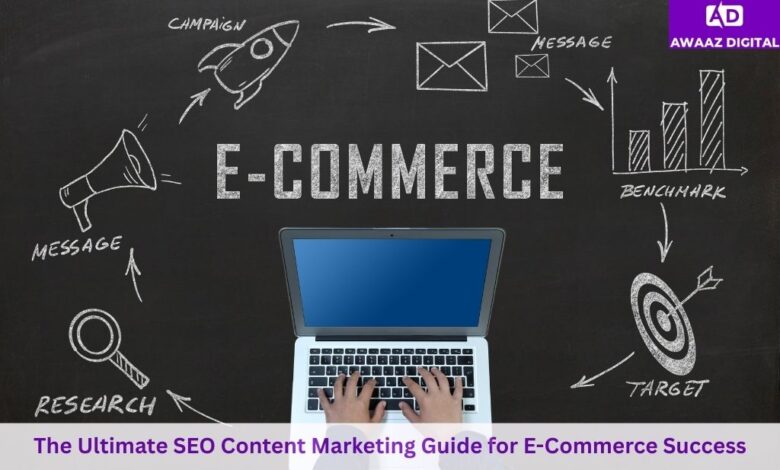The Ultimate SEO Content Marketing Guide for E-Commerce Success

Are you struggling to get your e-commerce business noticed by the right audience in the USA? While foundational efforts like website optimization, social media presence, targeted ads, and PPC are essential, leveraging an effective SEO content strategy can significantly amplify your results.
Although most businesses lack budgets for extravagant TV commercials, achieving higher traffic and sales isn’t impossible—it simply requires consistency, strategic SEO practices, and some diligent effort. By adopting the right SEO strategies, your e-commerce business can truly flourish.
What is E-Commerce Content Marketing?
E-commerce content marketing involves creating compelling content to attract, engage, and retain customers. This includes articles, product reviews, engaging product descriptions, and informative blog posts. Effective content marketing increases web traffic and encourages longer site visits.
Content marketing goes beyond written text, encompassing visual content such as images, videos, and infographics, each playing a crucial role in enhancing your brand’s visibility, especially in competitive markets like Florida, Dallas, California, and Texas.
Essential Content Marketing Strategies for E-Commerce:
Here’s how your business can harness the power of content marketing to boost traffic and sales:
1. Leverage Your Email List
Email marketing remains highly effective and cost-efficient. Instead of merely promoting new products or sales, engage your audience with personalized, meaningful interactions. After a customer purchase, request feedback or reviews to build trust and loyalty. Additionally, strategically reminding customers about abandoned carts can recover potential lost sales, addressing the fact that nearly 70% of shopping carts are abandoned.
2. Partner with Influencers
Influencer marketing, particularly through micro or nano-influencers, is highly effective. These influencers offer higher engagement rates, despite smaller followings, and often provide more genuine and relatable content. Partnering with influencers whose audience aligns with your brand can significantly enhance customer trust and product visibility.
3. Showcase High-Quality Product Images
In e-commerce, visuals matter. Professional, aesthetically pleasing product images help customers visualize using your products, encouraging purchases. Integrate captivating images into your blogs and social media posts, accompanied by useful tips or guidance, turning your website into an appealing, trustworthy resource.
For instance, a home décor brand can combine stunning product images with practical styling advice to inspire and attract customers.
4. Encourage User-Generated Content (UGC)
User-generated content, including reviews and customer-submitted images or videos, is invaluable. UGC significantly boosts credibility and authenticity, fostering trust and engagement among potential buyers.
Encourage customers to share experiences by hosting UGC contests or featuring customer stories prominently on your site. Brands like GoPro excel by continuously showcasing community-created content, further strengthening customer relationships.
5. Address Frequently Asked (and Unasked) Questions
Proactively answer customer queries—particularly those people hesitate to ask openly. Offering practical and accessible advice positions your brand as a helpful, trusted resource.
For example, a clothing brand might offer detailed styling guides addressing common fashion questions, providing value and convenience to customers who prefer discreet, quick answers.
6. Track and Analyze Your Marketing Efforts
Monitoring key performance indicators (KPIs) helps measure content effectiveness. Track metrics such as:
- Engagement (likes, shares, comments, page duration)
- Traffic sources (social media, organic search, paid ads)
- ROI (profitability of campaigns)
- Bounce rates (percentage of single-page visits)
- Email marketing analytics (open rates, click-through rates, conversions)
Utilize tools like Google Analytics and social media insights to refine your content strategy continuously, ensuring adaptability and maximized effectiveness.
7. Create Engaging Video Content
Video marketing is incredibly effective in engaging customers and showcasing your products vividly. Consider producing testimonials, unboxing videos, product demonstrations, or influencer collaborations. Tailoring videos for social media and paid campaigns boosts your content’s reach and impact.
8. Ensure Your Content is Shareable
Creating easily shareable content can significantly enhance brand visibility and generate valuable backlinks, essential for improving SEO rankings. Compelling, shareable content can organically attract backlinks over time, consistently benefiting your SEO efforts.
9. Develop a Comprehensive FAQ Page
An FAQ page effectively addresses common customer questions, preventing potential customers from seeking answers elsewhere. Providing quick, clear responses helps retain visitors, improving user experience and conversion rates.
Conclusion
Investing in strategic content marketing is highly beneficial for e-commerce businesses. Identify your audience’s interests, create informative content addressing their needs, and link relevant pages strategically. Captivating, consistent, and high-quality content combined with excellent visual design will set your brand apart, driving engagement and boosting sales long-term.




